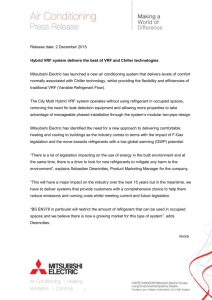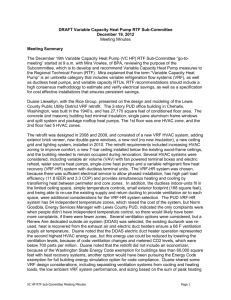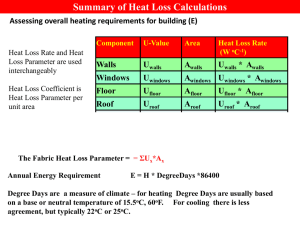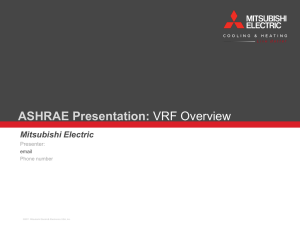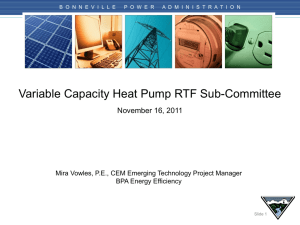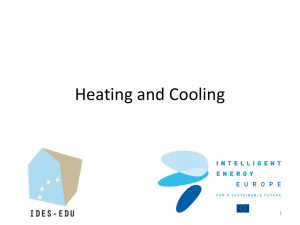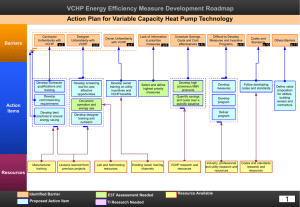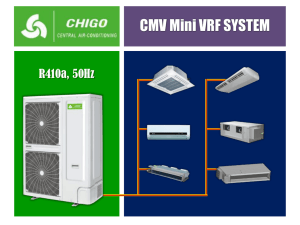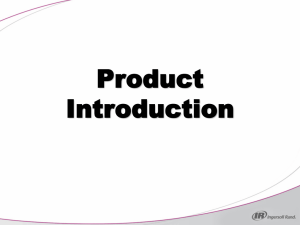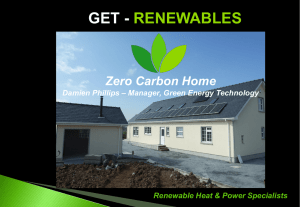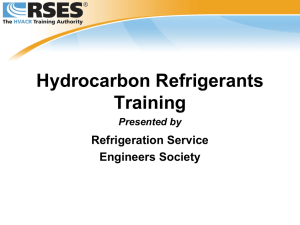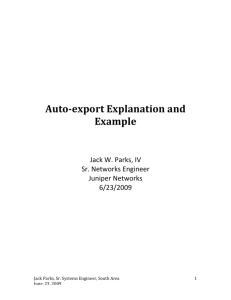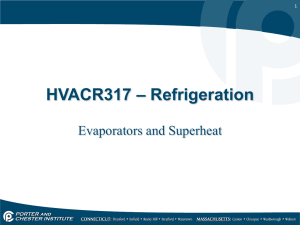VRF Applications ASHRAE (ASHRAE 15 & 34, ASHRAE TC 8.7)
advertisement
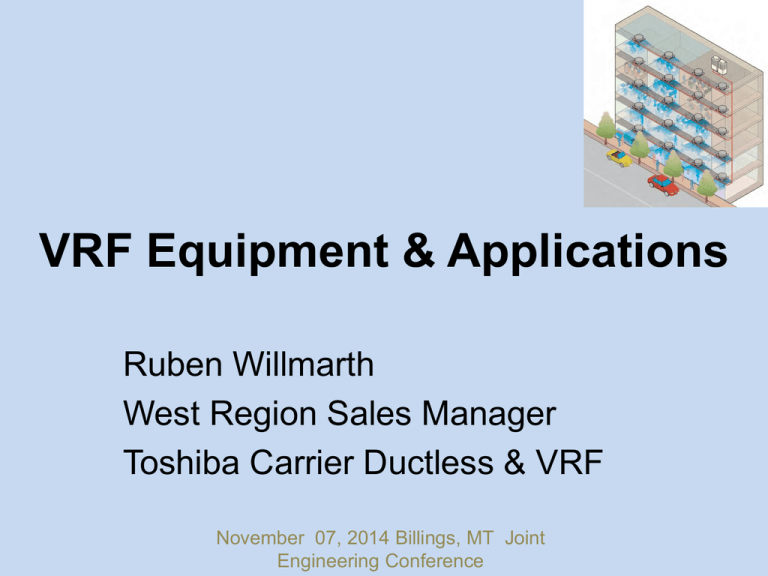
VRF Equipment & Applications Ruben Willmarth West Region Sales Manager Toshiba Carrier Ductless & VRF November 07, 2014 Billings, MT Joint Engineering Conference CONTENTS What is VRF Global Application Examples Benefits of VRF systems System Components Controls Basic Design Practices ASHRAE Std 15 & 34 WHAT IS VRF “VRF” system is a short for Variable Refrigerant Flow system. Refrigerant flow is varied based on demand - System where multiple (up to 50 indoor units) can be connected to outdoor units. - Fan coils are controlled individually or by group controls. - Refrigerant flows to the unit that is calling for heating or cooling. VRF Technology Overview Two VRF System Types HeatRecovery Pump Heat Simultaneous Cooling & Heating Single Mode: Cooling or Heating Only VRF Technology Overview Primary Components of a Heat Pump System Outdoor Unit Indoor Unit Controller • Controls Compressor Speed • Maintains Operational Mode • Transfers Heating and Cooling to Space • Allows for Optimal Zoning • Controls Space Temp and IDU Fan • Remote or Central Typical VRF Heat Pump System Outdoor unit Compressor Liquid line (fully liquid) Indoor unit Refrigeration Pipe (Liquid, Gas) Each indoor unit can be controlled individually. On/Off setting , Set point, Air volume, louver position can be set individually. (Operation mode priority : Cooling or Heating, not simultaneously in heat pump model) Cooling : Expansion=Indoor unit Liquid line=Condensed liquid Heating : Expansion=Outdoor unit Liquid line =Condensed liquid VRF Technology Overview How does VRF work? Indoor Outdoor Flow Selector Unit Unit Controller • • Transfers Houses multiple Receives heating superheated and inverter cooling gasdriven and directly subcooled compressors to theliquid, spaceadjusts Compressors flow direction change toAir heat Temperature speed and cool based onlevel demand of indoor • • Measures Allows for Return indoor unit control at zone Pulse units, Allows Motor which fordesired indoor Valve varies (PMV) unit theto refrigerant adjusts be in either tofan flow meet cooling setpoint or heating • • Takes user space setpoint, speed, mode • • Filters Segmented mode and distributes ODU Coilthe for air efficient heat transfer Unit operates to match exact building load Unit Unitoperates operatestotomatch matchexact exactbuilding buildingload load Typical VRF Heat Recovery System Simultaneous heating and cooling, uses 3 - Pipe cooling mode waste heat for heating Heat Recovery Box Typical VRF Heat Recovery System 2 - Pipe Varying Refrigerant Flow How does the outdoor unit respond to the varying demands and vary the flow of refrigerant? The compressor(s) in the outdoor units are inverter driven which means that their speed can be varied by changing the frequency of the power supply to the compressor. As the compressor speed changes, so does the amount of refrigerant delivered by the compressor. SYSTEM ADVANTAGES High Efficiency High High Reliability Reliability Stable Operation Use Wherever Part Load Exists Application: In case of: Not all units are on. Example: office area is on, meeting room is off. In case of: Orientation of building Example: East/West exposure In case of: Decreased load. Example: office closed OFF Apartment, Office building ZONING OPERATION OF VRF (In case of cooling) : Piping : 4-way cassette type : Hi-wall type : Outdoor units ADVANTAGES OF VRF - Comfort - Design flexibility - Energy savings (part load, heating) - Cost effective installation ADVANTAGES OF VRF COMPRESSOR COMPARISONS Rotary compressor Scroll compressor COMPRESSOR COMPARISON Twin rotary compressor Scroll compressor Out Out In In In ADVANTAGES OF VRF EASE OF DESIGN Multiple types of Fan Coils and Sizes provides design flexibility for many different applications ADVANTAGES OF VRF Modularity of equipment allows for Staging of installation, Redundancy in operation ADVANTAGES OF VRF HX, and ADVANTAGES OF VRF TECHNICAL TRAINING 1200 apartments in 7 buildings Recognized by China’s Ministry of Construction as being among the most cost-effective air conditioning systems available. Shengshi Qiantang Garden 3,840Tons 2 3 Jae Neung Education Building 2,400Tons 2 4 Portal Commercial Development 280Tons 2 5 Approx. 10,000 sq. ft 7 floor multi-tenant office building Burt Hill Architects Office 2 6 26 Installed in subway passages and administration offices Contracts extending to other lines China Subway 19,200Tons 2 7 27 DESIGNING WITH VRF High Efficiency High High Reliability Reliability Stable Operation Designing for Energy efficiency Perimeter/Core Office 107 3.0kBTU Pres. Office 12 kBTU Office 108 3.0kBTU 13.5 kBTU 6 1 12 kBTU Foyer 2.5kBTU Corr 2.0kBTU Rejected 2 5 Women’s 2.0kBTU Coffee/Brk 2.0kBTU 12 kBTU 2.5 kBTU Heat Office 104 3.0kBTU Office 105 3.0kBTU Men’s 2.0kBTU VP Office 14 kBTU 4 Office 106 3.0kBTU Conf. 28.0kBTU Office 110 7.5kBTU 20 kBTU Office 101 6.0kBTU 7 28 kBTU Corr 2.0kBTU 3 14 kBTU Office 110 4.5kBTU Office 109 3.0kBTU Office 102 6.0kBTU Office 103 6.0kBTU Example: 40oF Ambient Ventilation Design • Ventilation Strategies with VRF Room graphic w/Air into Corner Delivering OSA directly to the space: 1. Best when it is Neutral temperature & Humidity (DOAS) 2. An ERV-only is OK in the West & South, if low fraction and high ceilings (mixing time) 3. Mild Climates can bring in small fraction untreated 4. Benefits are less ducting, more flexible application 30 Ventilation Design Ventilation Strategies with VRF Delivering OSA ducted to the Fan Coil: 1. Pre-Filtered, tempered air is best. (DOAS) 1. 2. Allows selecting to meet Envelope load for max comfort Air inlet point is before the filter on some ductless, so Filter is a must! 2. An ERV-only is Good in the West & South, but may need additional heat in the North 3. DOAS system or ERV+FC is best for Cold Climates 4. Mild Climates can bring in small fraction untreated (<30%) 5. Benefits are better humidity control, no extra grills 31 Ventilation Design DOAS using an ERV 1. DOAS approach allows us to split the ventilation load away from the Mechanical system by tempering the air first. A. Can use an ERV only for most applications B. Can run OSA through a standard Fan Coil in Series for Neutral Air application, especially if not ducted to Fan Coils C. Can apply Supplemental Heat for Cold Climate applications for Neutral Air, or even higher 32 Heating Design Heating Design Strategies Heating with a VRF System: -VRF is a Heat Pump, but…. A. But it is not your Grandpa’s Heat Pump! B. Capacity is better than traditional because of inverter compressors that can spin faster to compensate C. De-rate due to ambient temperature is less, but must still be accounted for. D. Auxiliary Heat to cover the <average 33 Heating Design Heating Design Strategies- Avg. vs. Design: 1. The Design Heating in Billings is -20F 2. But the Average January Low is 16F “Avg. winter low in Billings, MT is 16F” 34 Ventilation Design Heating Design Strategies When to use Auxiliary Heat? A. Rule of Thumb is start considering it at 15F design temp. B. Simple Answer is when heating Design Day exceeds capacity C. ERV & DOAS can provide significant contributions. “Avg. winter low in Seattle, WA is 36F” “Avg. winter low in Chicago, IL is 17F” “Avg. winter low in Billings, MT is 16F” “Avg. winter low in Nashville, TN is 29F” 35 Heating Design Heating Design Strategies-Aux Heat Types of Aux. Heat: A. Electric Strip-Heater (Ducted Models only) B. Hydronic Coil (can feed from an upsized DHW source) C. Both of above can be placed in DOAS ducting for 90+F ventilation air if that meets the needed BTU’s! D. Baseboard Heating Panels A. Hydronic or Electric-All Fan Coils E. Radiant Panels A. Hydronic or Electric-All Fan Coils F. Wall Heaters A. Typically Electric-All Fan Coils G. Or….Previously Existing Heating System!! 36 Heating Design Heating Design Strategies-Aux Heat There are 3 ways to activate the Aux. Heat 1. Individual Space Response: 1. Zone temp drops, Aux heat activates at Temp. A, then deactivates at Temp B. Both must be less than heating setpoint 1. Outdoor Ambient Trigger. Aux heaters engage when FC is in Heating, Aux Heating system activated by separate Outdoor Ambient Thermostat. 2. BMS Control system activation. Can use custom logic for zone by zone response, minimize setpoint drift. 37 Heating Strategies • Heating Design Strategies-Aux Heat Heating Setback with VRF: A. A VRF system is different from a combustion heater because it’s efficiency gets better at part-load. B. When system is in recovery, system goes to full-load, which is less efficient than maintaining a constant temperature, but total heat loss is more. C. So, optimum use is probably minimal setback during weekdays, and more of a setback over weekends & Holidays, or just a 2F setback period. D. No setback during cold snaps to avoid using Aux Heat. 38 Heating Strategies • Heating Design Strategies-Aux Heat Alternate to zone-level Aux. Heat-Put Outdoor Units in a Mechanical Room or “Doghouse” 39 Heating Design • Heating Design Strategies-Aux Heat Alternate to zone-level Aux Heat-Put Outdoor Units in a Mechanical Room or Doghouse: A. Simplifies controls of Aux. Heat by having one set of controls and heat source. B. Heater is typically a Gas unit heater, or other combustion unit C. Backup isolates from Outdoor air at preset ambient temp. D. Key Selection Criteria: A. Size the Unit heater for 70-80% of Heat Load B. Ducting system must be 0.2” esp max. in both modes C. Activation temp typically below freezing, but maintain interior temp around 45F to avoid frost buildup. D. Don’t forget to include a condensate drain, w/heat tracing 40 Refrigerant system Design VRF and ASHRAE 15/34 In part, Standard 15, Safety Standard for Refrigeration Systems, strives to ensure a safe system by limiting the maximum quantity of refrigerant below that which is a danger to human occupants if a leak occurs. Because VRF uses the Refrigerant as the transport medium, it is inherently a more refrigerant intensive product than most traditional HVAC. Std. 15 is the application guideline that ensures a safe design every time. VRF and ASHRAE 15/34 Refrigerant Concentration Limit (RCL) R410A R410A is a commonly used refrigerant for commercial VRF systems. Per Standard 34, Table 2, the safety classification of R-410A is Group A1 (meaning non-flammable and nontoxic). Even though R-410A is Group A1, its ability to displace oxygen could pose a danger to occupants if released in large quantities into smaller-volume spaces. Therefore, Standard 34, Table 2 has established an RCL for R-410A at 26 lbs of refrigerant per 1,000 cuft of room volume. For Institutional Occupancies such as patient care areas of hospitals and senior homes, the RCL is cut in half, changing the RCL for R-410A to 13 lbs/1,000 cuft. VRF and ASHRAE 15/34 Smaller Capacity Systems Design for “Connected Spaces” Combine multiple smaller zones on a single ducted fan coil unit One to-One Systems Diversity Refrigerant Piping Layout Y-branching versus manifold Isolate refrigerant circuit for Smaller Rooms R410A sensor and alarm, or isolation valves Stephen W. Duda’s article published in ASHRAE Journal, July 2012. Posted at www.ashrae.org. Applying VRF? Don’t Overlook Standard 15 Questions ? Thank You
